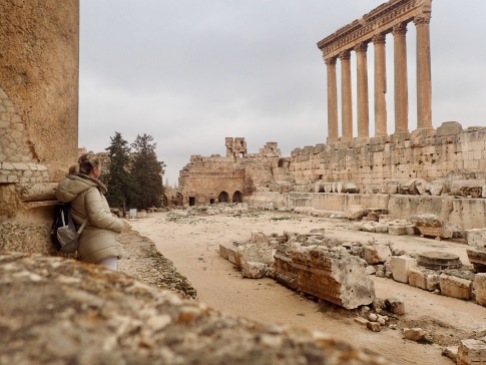Lebanon! What an incredible country. My first few days in Beirut was spent enjoying the famous Lebanese hospitality, exploring the historical sites and eating! I’m beginning to think this project should be called ‘The Gluttonous Pilgrim’. I’m enjoying the food and people just as much as the religious contexts that I find in every destination. There goes the yoga body! It is a Middle Eastern country with a European vibe. They say it is the Paris of the east. Walking through downtown Beirut, I can see why.
History is everywhere you turn in Lebanon, from the Garden of Forgiveness in Beirut sandwiched between the Mohammad Al-Amin Mosque and the St George Maronite Church ruins that are centuries old. The history is also evident at the sites in Jbeil (also known as Byblos) and Baalbek – the place of one of the world’s largest Roman ruins.
Down in the valley near the Syrian border is Baalbek, an almighty display of Roman grandeur, layers upon layers of civilisations, religion and faith threaded through each one. Here the Romans built temples dedicate to Venus – God of Love, Bacchus – God of Wine and Jupiter -God of Sky. A Triad of Gods at that time. Three – there’s that number again, so prevalent in so many faiths. I’ll be investigating that further. The temple of Bacchus was recently restored and is host to opera festivals. The expansive interior was once used for ceremony: a reminder of the rituals of the day. Then when the Byzantines moved in the temples were converted to cathedrals and churches for prayer and finally the Omayadd Empire converted sites to mosques and citadels.
Byblos and Anjar are also steeped in religious history. Wherever ruins are found, whether they be theatres, houses, stables, stores or fortresses, always close by is the house of worship, the temples of Gods and Goddesses, cathedrals or mosques. In Anjar there is evidence of a private mosque for the prince who came to Lebanon during the Omayyad era, the first Islamic rulers. Even in Byblos that dates back six thousand years to the Phoenicians, Temples for the God of War, the God of Love and Dance, among others.
If you want to explore the historical sites in Lebanon I highly recommend it. I was blown away by the construction and intricate details in the stone and marble buildings here. Our guide Natasha, an archaeologist, brought the stories to life through her passion for the past and jovial commentary on the quality of restoration works.
In modern times religion is highly debated; part of the reason I’m on this trip is to understand organised religions’ role in this modern world. One thing that has struck me about my trip to Lebanon is that all religions are here to stay. The sustainability of faith through war, evolution, progress and everything else the world throws at us is undeniable. Religion and faith survives. It is the centre of our ancestry and it shapes our future, whether we like it or not.
One theme that appeared at every site was cemented when I visited Tyre in the south where the necropolis of hundreds of people was discovered. And that is the acceptance of different religions is the centre of Lebanon’s culture. In Tyre, there is a Christian cemetery next door to a Muslim burial site, separated by a dividing wall. The echo of the call to prayer sounds, as the Maronite Church bell’s chime. My Muslim driver holds my hand through the ice so I can reach the hermitage of St Charbel to pray. The doors are open to their neighbours in Palestine and Syria, regardless of religion. Sure that situation brings its challenges for society and resources but the ‘honour thy neighbour’ principal is there. Pope John Paul II said, “Lebanon is more than a country. It is a message of freedom and an example of pluralism for the East and West”. I think he’s right .
Yours in Faith,
The Unlikely Pilgrim















Lebanon looks so interesting. I would want to visit it myself someday.
LikeLiked by 1 person
Sarah, It was incredible and the people were so friendly. You should definitely go.
LikeLike
This was really interesting to read about such fabulous history of ancient religions all merging through the centuries! What an experience you are having Aray!
LikeLiked by 1 person